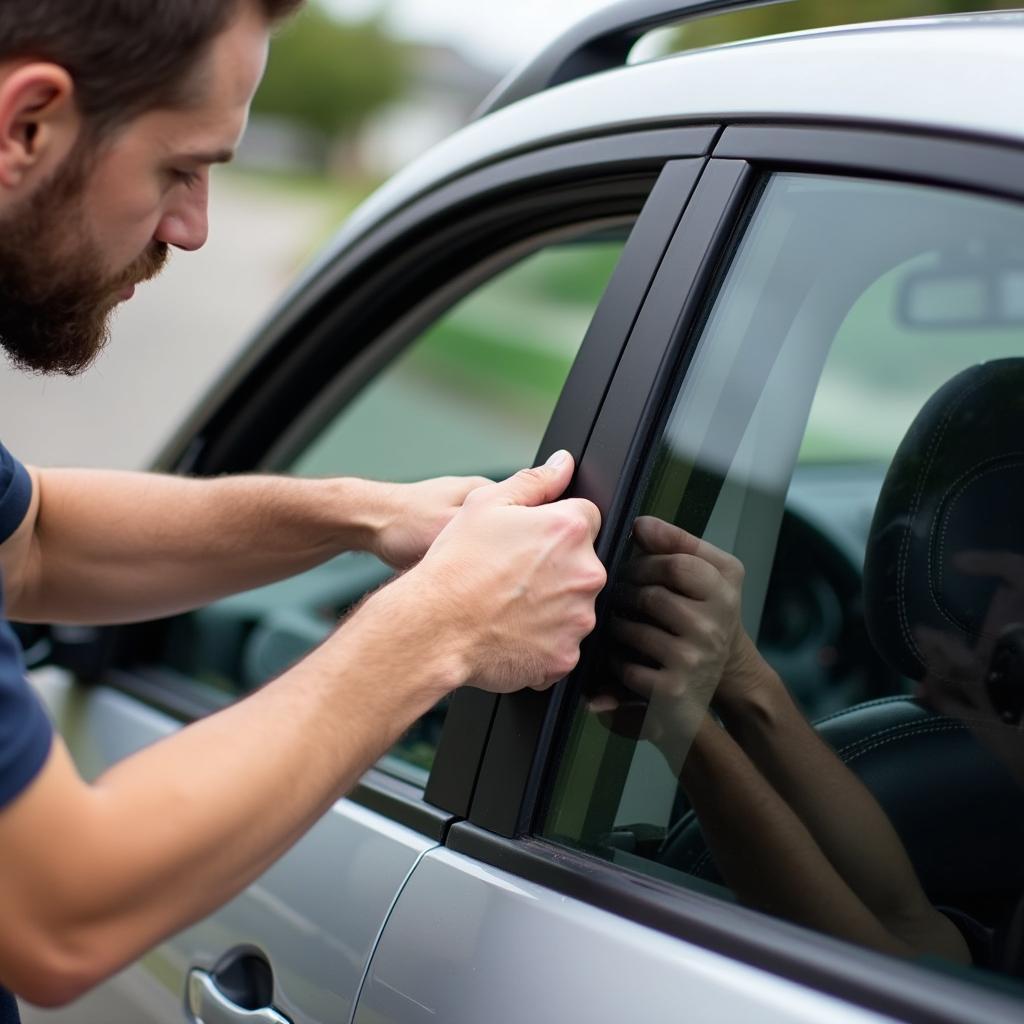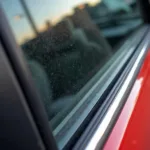Car window leaks are a common problem that can lead to water damage, mold growth, and a musty smell inside your vehicle. Fortunately, fixing a leaky car window is often a manageable DIY project. This guide provides a detailed walkthrough on how to identify the source of the leak and repair it effectively.
Identifying the Culprit: Where’s the Leak Coming From?
Before diving into repairs, it’s crucial to pinpoint the exact source of the leak. Water can seep in through various areas:
- Window Seals: Rubber seals around the window deteriorate over time, creating gaps for water intrusion.
- Window Tracks: Debris, dirt, and leaves can clog the window tracks, preventing proper drainage and leading to leaks.
- Door Seals: Damaged or worn-out door seals can allow water to enter the car’s cabin, especially during heavy rain.
- Window Regulator: In case of power windows, a faulty window regulator can cause the window to sit improperly, resulting in gaps and leaks.
DIY Car Window Leak Repair: Step-by-Step Guide
Once you’ve identified the source of the leak, follow these steps to repair it:
1. Gather Your Supplies:
- Clean rags or microfiber cloths
- Shop vacuum with crevice attachment
- Silicone-based lubricant
- Replacement weatherstripping (if necessary)
- Silicone sealant or automotive gasket sealer
2. Clean the Area:
Thoroughly clean the area around the leak, removing any dirt, debris, or old sealant. Use a shop vacuum to clear out the window tracks and crevices.
3. Inspect and Replace Seals:
Carefully examine the rubber seals for cracks, tears, or gaps. If the seals are damaged, replace them with new weatherstripping. Apply silicone-based lubricant to the new seals for a watertight fit.
4. Apply Sealant:
For small gaps or cracks in the seals or window tracks, use a silicone sealant or automotive gasket sealer. Apply a thin, even bead of sealant to the affected area, ensuring complete coverage.
5. Check the Window Regulator (Power Windows):
If you suspect a faulty window regulator, consult a mechanic or refer to your car’s manual for specific instructions on inspection and repair.
6. Test Your Repair:
After the sealant has dried completely, spray water around the repaired area to check for leaks. If you still notice water entering the car, re-evaluate the repair and repeat the necessary steps.
When to Seek Professional Help
While minor car window leaks can be fixed at home, some situations may require professional assistance:
- Extensive rust or damage to the window frame
- Complex electrical issues with power windows
- Lack of confidence in performing the repair yourself
Remember, a professional mechanic has the expertise and tools to diagnose and repair complex car window leak issues effectively.
Expert Insights
“Many car owners underestimate the importance of regular maintenance for window seals,” says John Smith, a seasoned automotive technician with over 20 years of experience. “Regular cleaning and lubrication can significantly extend the life of your seals and prevent leaks.”
classic car window repair near me
Conclusion
Repairing a leaky car window is crucial to prevent water damage and maintain a comfortable driving experience. By following the steps outlined in this guide, you can effectively address this common car issue. However, don’t hesitate to seek professional help for complex repairs or if you’re unsure about handling the process yourself. Keeping your car’s windows in good condition ensures a dry, comfortable, and enjoyable ride every time.
FAQs:
1. Can I use any sealant for car window leaks?
It’s best to use a silicone sealant or automotive gasket sealer specifically designed for automotive applications.
2. How long does it take for the sealant to dry?
Drying time varies depending on the type of sealant used, but it typically takes 24 hours for a complete cure.
3. How often should I replace my car window seals?
Inspect your window seals annually or sooner if you notice signs of damage. Replace them as needed to prevent leaks.
4. Can a leaking car window affect my car’s electrical system?
Yes, water intrusion from a leaky window can potentially damage electrical components, especially in areas near the doors and dashboard.
5. How much does it cost to repair a car window leak professionally?
The cost of professional repair depends on the severity of the leak and the labor rates in your area.
6. How do I know if my car window regulator is faulty?
Signs of a faulty window regulator include slow window movement, grinding noises, or the window not going up or down completely.
classic car power window repair
7. Can I prevent car window leaks?
Yes, regular cleaning of window tracks and lubrication of seals can help prevent leaks. Parking your car in a covered area can also minimize exposure to the elements.
For more information on car window repairs and other automotive topics, explore our website or contact our expert team for personalized advice.
Need assistance with your car window leak? Don’t hesitate to reach out! Our team of car repair specialists is available 24/7 to answer your questions and provide expert guidance.
Contact us via WhatsApp: +1(641)206-8880
Email us at: [email protected]
We’re here to help you get back on the road with confidence!



